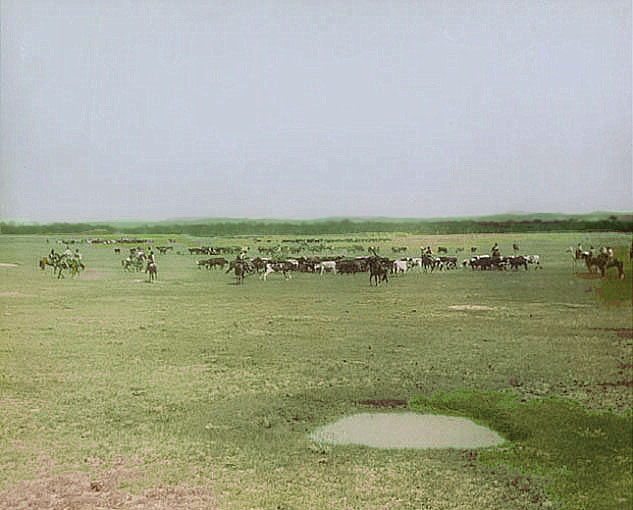
Roundup on the Big Dry, approx. 1880's
The Big Dry lies south of Fort Peck Reservoir and North of the Pryor and Beartooth Ranges and eastward almost to the Dakota
border, centering on the town of Jordan. As previously noted, the Big and Little Dry were the home range of the N Bar N on which
C. M. Russell worked. The Ranch, north of Miles City was founded by the Niedringhaus Brothers of
St. Louis with the fortune made from the manufacture of "Graniteware." The Niedringhaus Brothers' Home Land and Cattle Company was one of
the mega cattle companies utilizing free range in the Big Dry. Others grazing cattle there included
the C Y from Wyoming (see Casper) located just across the border in Harding County, South Dakota, the X I T from North Texas whose Montana unit
was located on Cedar Creek 60 Miles north of Miles City, the L 7,
the Phillips Land & Cattle Co.'s L U bar, the Bow and Arrow located between the Musselshell and the Missouri and
the W bar owned by Pierre Wibaux located at the mouth of the Little Dry.
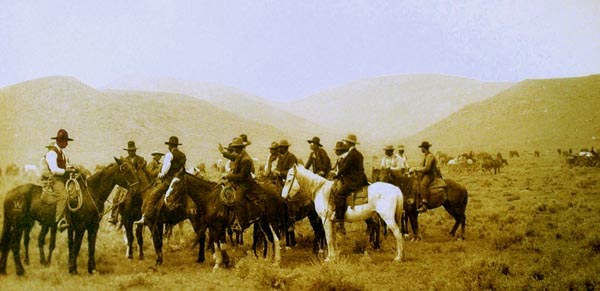
Wibaux Roundup Crew receiving instructions,
approx. 1880's. Note the Wibaux W bar brand on the foreman's horse.
By the early 1900's the Big Dry had changed. At one time, Wibaux's W bar had as many as 65,000 head of cattle.
By 1917, Wibaux, according to the county Property Assessor, had 2348 milch cows, 8,130 head of cattle, and
1955 sheep. William Hornaday explained:
At the head of Sunday Creek, the plain and simple bad-lands of that stream
fade out, and you emerge upon a vast stretch of rolling prairie uplands,
absolutely treeless, and drained by numerous small creeks. In days gone
by that was one of the finest buffalo ranges in all the West. After the
buffalo days, this side of 1884, it was a fine cattle range; but the
awful sheep-herds have gone over it, like swarms of hungry locusts, and
now [1908] the earth looks scalped and bald, and lifeless. To-day it is almost as barren
of cattle as of buffaloes, and it will be years in recovering
from the fatal passage of the sheep. That once-popular buffalo range
extends northward over divide and valley, across the Little Dry,
Sand Creek and the Big Dry, ninety miles at least, where it breaks
into the awful badlands that scarify the country along the southern
side of the muddy Missouri. Hornaday, William T.: "Diversions in
Picturesque Game-Lands," Scribner's Magazine, July, 1908.
Hornaday was from the Museum of Natural History in New York. On his visit to the Big Dry in 1902, Hornaday was accompanied by Layton A. Huffman of Miles City;
Jim McNaney, a former Texas cowboy and Buffalo Hunter who served as guide; and wagon driver Bent Smith.
Huffman cameras and glass plates were kept in a buggy that was pulled over faded buffalo trails. Honraday reviously visited the Big Dry in 1886.
A buffalo killed on that trip was placed in the Museum and was according to Hornaday used as the model for the image on
the 1901 $10.00 note.
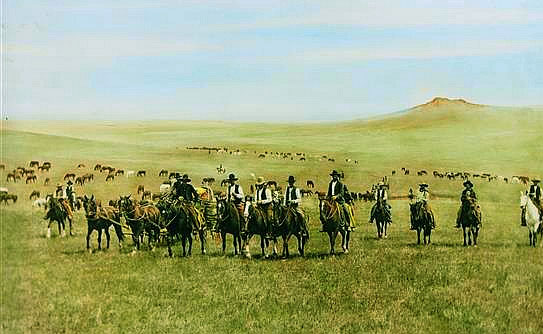
Roundup on the Big Dry, 1886.
In 1886, the N bar N opened a unit in Wood Mountain, Saskatchewan. They brought in 8,000 head of cattle. After the winter of 1886-87, they retreated back to the States with two thousand head.
Niedringhaus Brothers also had over 600,000 acres
in Texas leased from the White Deer Land Company. White Deer had foreclosed on its predecessor, the Francklyn land Company owned by the grandson of Sir Samuel Cunard founder of the
Cunard Lines. Money for the Francklyn operations had been provided by the Cunard and Balfour families.
Charles G. Franckly was, to say the least, extravagant with his family's money, perhaps putting even Moreton Frewen to shame.
Sir Gordon Cunard, the 4th Baronet and his associates in White Deer were less than pleased. It became necessary for Arthur Balfour, later Prime Minister, himself to travel to
Texas. Balfour fired the ranch's manager, Col. B. B. Groom, and recommended that the ranch be put into receivership. Groom was described by Willie Newbury Lewis in his
"Tapodero: the making of a cowboy" University of Texas Press (1972) at p. 118 as "a pompous Kentucky Colonel who treated cowboys as if they were stableboys * * *." In one instance he
mistook a Turkey Track
"Rep" for one of his own cowboys and severely bawled him out. The rep dismounted and proceeded to give
Groom a first-class whipping. When the Bar X and the Diamond F were organized, the company
purchased 40,000 head with which to stock the range. It was the largest single sale of cattle at the time in the historoy of the
Unted States.When Francklyn operations were liquidated. See New York Times, December Dec. 21, 1887. When the Bar X and the
Diamond F were liquidated, only 6,000 head could be found. In "Trail Drivers of Texas, John B. Donner of Yoakum, Texas, recalled that in 1885, as a young man of 18 he participated in a drive to Colorado of 3,000 head branded
Bar X. The cattle were picked up on the Goodnight Ranch.
The losses were believed to have been excess of $3,000,000. Sir Bache Cunard was livid. Francklyn was supposedly
managingSir Bache's money but used it for his own purposes. Sir Bache ultimately had
Francklyn jailed. Francklyn cooled his heels in New York's old Ludlow Jail for about six weeks until
Francklyn was able to convince a judge to lower the bail. In the meantime,
Francklyn allegedly bribed the jailer to let him out during the day to "consult" with his lawyers.
The New York General Assembly investigated a claim that Francklyn was let out one evening
to host a dinner party. The jail was basically a debtors' prison for those who could not pay alimony.
Among its more famous inmates was Victoria Woodhull. Boss Tweet died in its confines.
The Cunard interests organized the White Deer Land Trust who foreclosed upon the ranch.
Cunard certainly did not want to raise cattle. Thus the Trust leased
the property to the N bar N until the Trust determined to liquidate. It became necessary for the N bar N
to trail the cattle up to Montana in the largest cattle drive in history, 25,000 head in 1892 and 40,000 head in 1893 with over 100 cowboys in teams of ten drovers each. The drive was delayed when
Kansas would not let them pass and they had to go through Colorado. It took until after World War II before the
liquidation could be completed. The former headquarters building for the N bar N in Texas is now a museum.
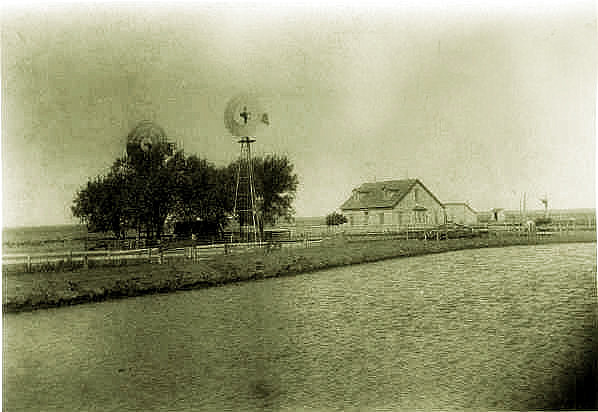
N bar N headquarters building, on White Deer Creek, Texas.
The building was allegedly the first building in Carson County. The area was described by Judge James Christopher Paul (1852-1935) in "EarlyDays in Carson County":
In 1887 the management of this extensive estate [White Deer Land Trust] passed to George Tyng, of Victoria, Texas,
who began some scattered improvements on it, such as wells and
windmills. Colonel Groom had originally built an old house of cotton
wood logs on White Deer Creek, which was the first building erected in
the County. Mr. Tyng later moved the ranch headquarters to a point a
few miles south of where the town of White Deer now stands.
George Tyng ultimately moved to Utah where he operated a silver and lead mine. He was killed in
1906 when his office building was wiped out by an avalanche. Judge Paul continued with his description as his first saw the area in January, 1888:
It was a beautiful, smooth prairie, as far as the eye could see - not a tree not even a shrub
knee high, to hide a Jack-rabbit, for miles in every direction.
No fences, no roads, no houses, only a handful of people around Panhandle,
the only settlement then in all of that plains country.
The sole occupants of the great plains were thousands of antelope,
scattered far and wide wherever one went. As I now remember my early
impressions, the one subject always discussed when conversation lagged,
was, "Will this country ever produce anything but grass?" "Can farmers ever
live here?" "Ought we to ever plow up the land?"
The older cattle men generally agreed that to plow up the original sod,
was to permanently ruin it. The writer now confesses to have agreed
with them for the first ten years he was there.
In this early day, the saloons flourished, each with a gambling hall
adjoining. "Jim McIntire" and "Smoky Jim", two famous gamblers helped
to make the town famous.
Then, too, the Dance Hall flourished. And many an old time cow-boy,
such as Mac Sanford and Cal Merchant, could tell interesting tales of
how it felt to leave town dead broke, to follow the chuck wagon another
month.
Pictorial documentation of cattle grazing on Montana's Big Dry in the 1880 and
90's, is for the most part dependent upon the photographs by
L. A. Huffman upon which the above two images are based and the art of C. M. Russell who was
a cowboy for the N bar N.
The cowboys of the time, had problems with the name of their employer. One, Eb Jones who rode as a cowboy for most of the
big outfits in Montana, South Dakota, and Wyoming referenced his employer's name as "Neathouse." Charles Nebo "Nib" Jones called it the "Neetingham Cattle Company. Nib
perhaps illustrates the difficulty in hiring sufficient cowboys for the drive from
Texas to Montana. He with his brothers allegedly participated in New Mexico's Lincoln County War. According to Nib, in 1887 his brother found along the Roswell Road an
abandoned wagon with its tongue raised to an upright
position. From the end of the tongue Andy Boyle's body dangled, a rope around his neck. Boyle had a reputation as a rustler and had
participated in the burning of Alexander McSween's house, "the Big Killing." The official verdict was that Andy had "died from unknown causes."
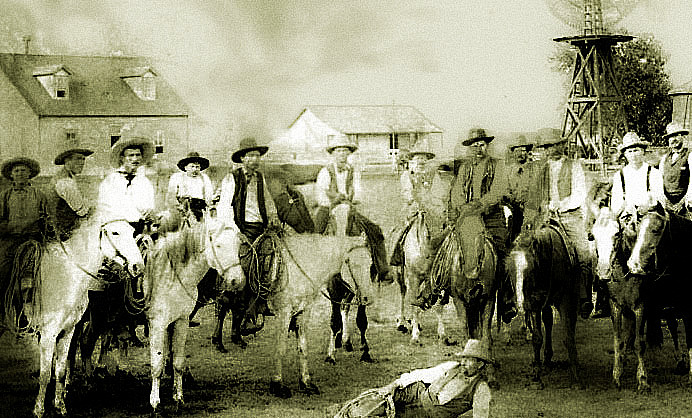
N bar N cowboys at White Deer, Texas, approx. 1888.
Cowboys who may have had a dubious reputation and who came north were at one time associated with the N bar N included "Long" Nenry Thompson, Harvey Logan (Kid Curry), and Harry Longabaugh (the later, the
Sundance Kid). Mary L. Helland, in "Montana-Women's History Matters,"Romancing Montana, Frances Parker, Western Writer," wrote
There was a fair share of desperados among the
N Bar N cowboys. Those trail hands who did not
return to Texas in the fall were often running from
a checkered past, and many a good cowboy came to
Montana after the Johnson County War and needed
to start over with a new name. Through the years,
twenty-one N Bar N cowboys would be arrested as
outlaws or gunslingers.
Helland continued that C. M. Russell later depicted Thompson in his painting, "the Poker Game":, "The rugged
cowboy playing cards was an exact photograph
of Long Henry Thompson, one of N Bar Nís most
notorious gunslingers."
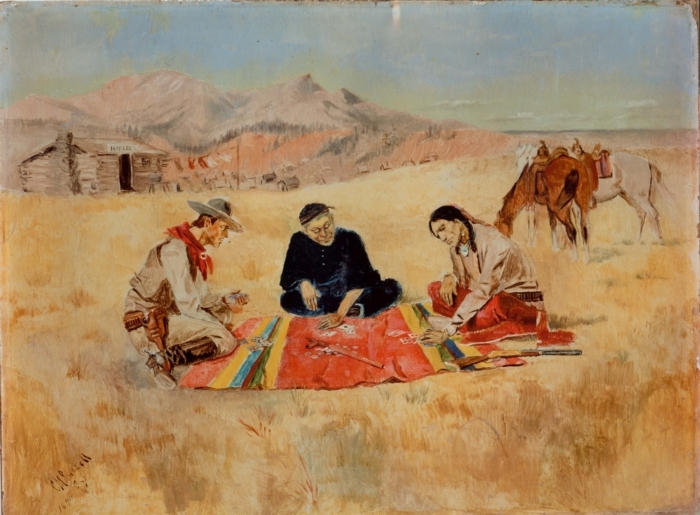
"The Poker Game," C. M. Russell, 1894.
As will be noted in a later chapter, Wild Bunch
Between robberies, Butch Cassidy and Sundance took honest jobs as cowboys. Those jobs were,
however, with ranches that were "off the beaten path" so to speak. An example was the W S in Western New Mexico, near Alma. The
N bar N certainly fit the bill, some ninety miles from Miles City.
Music this page: "Blue Prairie" as sung by the Sons of the Pioneers.
Next Page, Roundups continued.
|